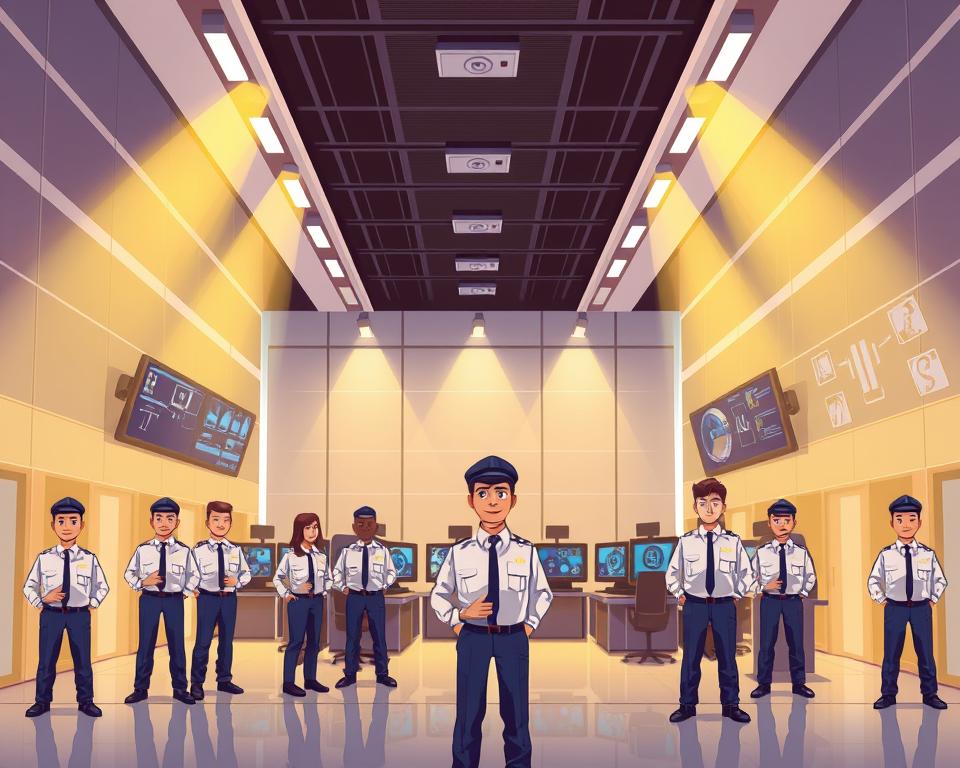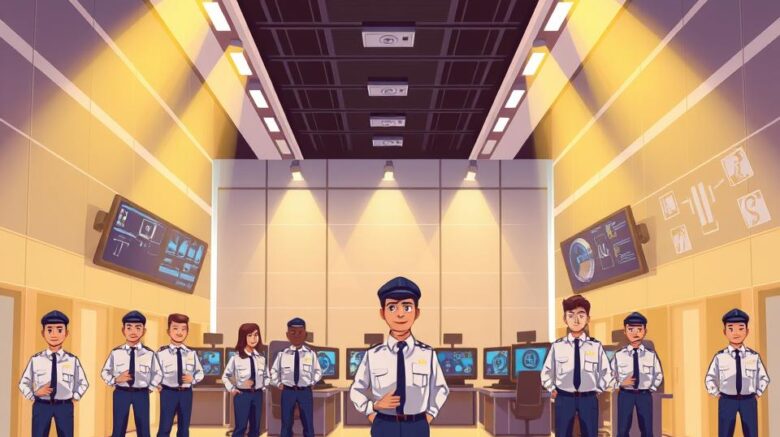Advancing Your Safety using Mall Security Measures
Imagine if the secret to safer shopping goes beyond cameras and guards? As shoppers increase and threats transform, secure spaces demand more than conventional methods. Current security issues need clever approaches merging human skill and modern technology.
With rising concerns about public safety, companies now emphasize strong protection systems. Divine Protection Services champions this movement, fusing extensive training and cutting-edge tools to establish industry norms. Their philosophy centers on proactive 24/7 security guards tactics rather than reactive measures.
Properly trained officers are crucial for keeping order. They monitor busy areas, manage emergencies, and build trust through visible presence. This people-first philosophy secures the sense of safety for both shoppers and employees during each visit.
Subsequent parts will show how surveillance improvements and access controls establish smooth security networks. Learn how strategic planning turns malls into safe havens while driving business growth.
Grasping the Need for Mall Security
Establishing safe areas for patrons and staff involves more than visible patrols. Current security programs count on layered tactics combining technology, training, and teamwork. These systems don’t just react to problems—they prevent them.

The Function of Surveillance and Access Control
HD cameras and intelligent entry systems form the core of contemporary safety plans. Carefully located sensors oversee crowded areas like entryways and parking spaces. This structure enables teams to identify irregular activity promptly.
Entry control tools confine access to designated areas while enabling customers to walk freely through stores. Regular equipment checks ensure cameras and scanners work flawlessly. Real-time monitoring allows teams to act before little problems escalate.
Security, Reputation, and Customer Experience
Properly trained officers do more than monitor screens—they help lost visitors and calm conflicts. Their presence comforts customers, fostering longer stays and return visits. A single event can erode trust, making prevention essential.
Supporting ongoing staff education makes certain teams respond to medical crises or crowd surges efficiently. When protective actions mesh with daily workflows, firms flourish in safer environments.
Divine Protection Services: Your Ally in Mall Safety
When safety is critical, organizations need partners who give more than pledges. Divine Protection Services differentiates itself by fusing cutting-edge tools with trained personnel to tackle today’s threats. Their methods adjust to changing threats while preserving a friendly environment for guests.
Our Comprehensive Security Approach
This agency integrates three pillars for utmost effectiveness:
- Sophisticated surveillance networks tracking high-traffic areas
- Access control systems that regulate entry without impeding foot traffic
- Regular equipment upgrades ensuring reliable performance
Their crew uses live data to recognize odd patterns, from unattended bags to unpermitted entries. This proactive method prevents issues before they escalate, keeping public spaces secure yet accessible.
Strengthening Security Officers with Training and Support
Divine Protection Services allocates major funding to skill development. Officers receive:
- BST certification for managing aggressive situations
- First aid preparation for medical crises
- Customer service workshops enhancing visitor interactions
Regular learning opportunities make sure teams are prepared for multiple situations. “Our people aren’t just guards—they’re safety ambassadors,” notes a company spokesperson. This attention to growth instills confidence in both personnel and customers, establishing environments where everyone flourishes.
Training, Certifications, and Team Excellence in Security
Empowering security personnel starts with more than just a uniform—it demands rigorous preparation. Teams excel when armed with certifications and practical exercises designed for modern challenges. This groundwork transforms daily interactions into chances to foster trust and avert incidents.
Core Training Programs and Certifications
Security staff initiate with three principal certifications: BST for conflict resolution, first aid for medical crises, and non-violent intervention strategies. These capabilities assist in calming tense situations while prioritizing guest safety. Periodic seminars renew these capabilities, making sure teams adjust to emerging threats.
Simulation drills imitate real-world incidents such as crowd surges or missing children. Onsite courses address current trends, from digital tracking tools to accessibility measures. “Training never ceases—it grows,” explains a Divine Protection Services instructor. This strategy keeps teams equipped for both everyday duties and unforeseen alarms.
Establishing a People-First Culture in Security
Ongoing education nurtures empathy and problem-solving skills essential for public areas. Security staff trained in customer service support shoppers with directions or store advice, merging safety with hospitality. This dual emphasis shapes welcoming atmospheres where people feel appreciated.
Divine Protection Services bolsters this culture via mentorship schemes and equipment mastery workshops. Assured, well-supported teams lower risks while reinforcing community connections. The result? Safer shopping areas where employees and visitors alike can focus on what matters most.
Mall Security: Recommendations for a Safe Shopping Environment
How do bustling shopping malls combine security with a pleasant visitor experience? The key is pairing attentive technology with welcoming personnel. Modern strategies focus on preventing issues while maintaining welcoming atmospheres.
Optimizing Visibility Through Technology
High-def cameras now monitor crucial areas like parking garages and food courts. These platforms apply motion sensing to detect odd actions, like unattended items or erratic movements. Consolidated dashboards enable teams to monitor multiple areas simultaneously.
Frequent maintenance inspections make sure sensors and alarms perform faultlessly. “Our weekly system evaluations avert 90% of possible malfunctions,” says a retail safety manager. Pairing live feeds with AI analytics helps spot patterns human eyes might miss.
Integrating Safety With Hospitality
Well-trained officers often double as information guides. They guide shoppers with store directions, lost items, and parking queries. This dual function cultivates trust while ensuring security.
Entry control tools like smart turnstiles restrict access to staff areas without impeding foot traffic. Color-coded badges help identify authorized personnel quickly. At peak periods, temporary checkpoints direct crowd movement near popular stores.
Monthly collaboration meetings between teams ensure everyone understands emergency protocols. Small changes—like improved lighting near restrooms—can ward off incidents while enhancing visitor comfort. When tech and teamwork synchronize, public spaces become safer and more pleasant.
Handling Emergencies and Crowds in Shopping Malls
When every second matters, how do packed spaces turn chaos into order? Successful emergency strategies fuse clear protocols with rehearsed teamwork. Preparation turns potential disasters into manageable situations where everyone knows their role.
Effective Emergency Management Techniques
Preplanned action plans are crucial in emergencies. Teams employ color-coded signals to denote various threat levels—red for fires, yellow for medical issues. This method allows personnel to act rapidly without confusion.
Primary strategies encompass:
- Designated evacuation routes marked with glow-in-the-dark signage
- Real-time communication via encrypted earpieces
- Automatic lockdown functions for off-limit zones
Guards instructed in crowd psychology steer visitors with composed verbal cues and visual signals. “We conduct疏散 drills monthly to maintain instinctive responses,” shares a retail safety coordinator. Video feeds help spot bottlenecks, enabling teams to reroute traffic before panic spreads.
Local fire services get real-time updates via integrated systems during incidents. Cooperative training drills guarantee smooth teamwork. After-action reviews pinpoint areas for improvement, like faster first aid deployment.
One Midwest shopping center lowered evacuation times by 40% after enhancing their PA network. Continuous updates to response plans ensure teams respond to new challenges while preserving visitor confidence.
Tech Developments and Emerging Trends in Mall Security
Imagine entering a place where safety systems foresee threats before they occur. Leading-edge developments are altering how public venues protect visitors while improving convenience. From AI-based analytics to biometric scanners, next-gen solutions combine precision with seamless function.
Smart Systems for Proactive Protection
Machine learning now analyzes camera feeds to detect unusual behavior, like unattended bags or erratic movements. These tools mark possible risks quicker than manual monitoring. Predictive models assess historical data to forecast peak traffic times, helping teams allocate resources efficiently.
Next-gen access systems use facial recognition to allow entry to restricted zones. “Biometric solutions lower unauthorized access by 78%,” notes a retail safety expert. Real-time dashboards provide crowd density data, allowing officers to reroute foot traffic before bottlenecks develop.
Training courses now include virtual reality simulations. Officers practice handling scenarios ranging from medical emergencies to active threats. This practical method fosters muscle memory for high-stress scenarios.
Upcoming trends indicate drone patrols for parking lots and IoT sensors spotting environmental hazards. As tech develops, shoppers receive smoother visits while feeling safe. Organizations embracing these tools keep ahead in establishing spaces where security and satisfaction prosper unitedly.
Final Thoughts: Advancing Mall Safety with Confidence
Creating safer mall environments begins with trust in both planning and execution. Divine Protection Services drives this initiative by blending AI-based tools with thoroughly trained personnel. Their method converts basic protocols into flexible systems that respond to emerging challenges.
Current safety rests on three pillars: live surveillance, exact access control, and quick emergency response. Squads leveraging predictive analytics can detect risks before they intensify, while customer-centric officers ensure seamless operations. This blend of tech and humanity creates spaces where visitors feel protected yet free to explore.
Committing to ongoing improvements guarantees long-term success. From biometric scanners to crowd management algorithms, innovation keeps properties ahead of threats. Partnering with experts like Divine Protection Services guarantees tailored solutions that grow with your needs.
Ready to improve your safety standards? Explore how cutting-edge systems and compassionate service can transform your space. Peace of mind begins with proactive partnerships—make the move to a safer future today.
Common Questions
How does access control enhance safety in public areas?
Access control restricts entry points, cuts unauthorized access, and assists teams in tracking foot traffic. Devices like keycard readers or biometric scanners assure only approved visitors enter restricted areas, fostering a safer environment for everyone.
What certifications should security officers have?
Officers should hold certifications like CPR/First Aid, crisis intervention training (CIT), and state-mandated licensing. Programs like ASP baton training or de-escalation workshops also prepare teams to handle high-pressure situations effectively.
How do surveillance systems handle large crowds?
Contemporary systems employ AI-driven cameras to follow movement patterns and spot anomalies. During peak hours, live feeds help teams redirect foot traffic, manage bottlenecks, and respond quickly to incidents without disrupting shoppers.
Why is customer service important for security personnel?
Amicable interactions foster trust and motivate patrons to report concerns. Officers trained in communication skills can assist with directions, lost items, or minor conflicts, enhancing the overall experience while maintaining vigilance.
What part does technology play in emergency response?
Tools such as panic buttons, real-time communication platforms, and merged alarm systems allow teams to coordinate more quickly. For instance, automated alerts can secure sections or manage evacuations during critical times.
How does Divine Protection Services back its teams?
They offer continual training, high-tech tools such as body cameras, and constant operational backup. Regular drills and access to industry experts ensure officers stay prepared for evolving challenges in public spaces.
Can AI minimize risks in retail environments?
Yes! AI studies data to forecast theft or accident hotspots. Cameras with facial recognition or license plate tracking also help identify repeat offenders before issues escalate.
What strategies prevent conflicts during busy seasons?
Prominent signage, designated rest zones, and staggered entry points reduce congestion. Guards educated in crowd control employ non-confrontational methods to defuse tensions and maintain order.
